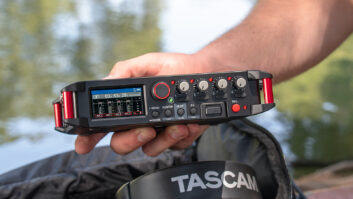Field Report: Mackie Onyx Blackbird
Jul 1, 2011 1:00 AM, By Chris Wygal, CBRE
Radio production facilities are interesting places. Hard-hitting, high-quality audio production can (for the most part) be accomplished with tried-and-true stereo in and out. Occasionally, however, multitracking is needed. For example, I recently recorded a university chamber choir to be used on a special radio program on our network. For the best recording (in this case), I ended up tracking five mics. When this type of project occurs, especially when pristine audio is a must, FireWire technology is my immediate go-to. The Onyx Blackbird from Mackie is a fantastic solution for making a PC or Mac workstation a 16-track (or more) recording powerhouse.

A few facts
The Onyx Blackbird lives in a 1RU chassis and interfaces via FireWire. The Onyx name is derived from Mackie’s high-end line of microphone preamps, which the Blackbird uses on all eight analog inputs. The first two Onyx preamps have an 80Hz roll off, and can be switched between mic and line. Two insert jacks allow for external processing of inputs one and two. All eight inputs have 48V phantom power available. Six other inputs can be used as mic or line. Up to four Blackbirds can be linked via FireWire for a total of 32 controlled inputs. (Up to eight Blackbirds can be inter-connected for up to 64 inputs.) The Blackbird will sync internally, but will also accept a word clock reference via BNC jacks. Optical Toslink ADAT lightpipe S/MUX II) inputs and outputs are located on the rear of the unit with sampling rates from 44.1kHz to 96kHz. The power plug-in is a simple IEC cord. For analog monitoring, stereo main, alternate and monitor outputs are found on 1/4″ TRS jacks.
Each analog input has a familiar Mackie gain control knob with the “U” indication. When set at U (unity), the incoming gain structure is not affected. However, the mic inputs can be ramped up 60dB, and the line level inputs can be attenuated 15dB or amplified 45dB. Each input has a dual-colored LED that indicates good input levels by lighting as green. The LEDS will turn red when the inputs are overdriven. Inputs 1 and 2 have high-pass filters, and a Hi-Z switch that allows for proper impedance matching when plugging a guitar directly into the 1/4″ line input jacks. The direct monitor section allows musicians or vocal talent to monitor inputs 1 and 2 prior to the Blackbird’s digital processing or routing. This allows for zero-latency, and can be monitored in stereo or mono. The direct monitor section works in tandem with the monitor level. The monitor output can feed powered monitors or amplifiers via 1/4″ jacks on the back of the Blackbird.
Two sets of headphones can be used on the front panel, with individual level control. Audio from an onboard mix or custom mix from the Blackbird Control software can be routed to the headphones with the push of a button. A green LED on the front panel indicates whether the Blackbird is receiving acceptable clock sync as a standalone unit or from its host.
The back of the Blackbird is a busy yet simple place. There are two Firewire jacks for host control and connection to another Blackbird, two BNC word clock jacks for syncing and four optical Toslink jacks for ADAT I/O. Alternate L/R out jacks provide an unbalanced output for a headphone amp or external audio device. The balanced main out jacks can be used in live applications when a mix of the Blackbird input channels is needed. The monitor jacks correspond with the monitor control previously mentioned on the front of the Blackbird.
— continued on page 2
Field Report: Mackie Onyx Blackbird
Jul 1, 2011 1:00 AM, By Chris Wygal, CBRE
Control freak
A 1RU preamp with multiple I/O options, gain control and some monitoring features is cool. If the preamps are pristine, that’s better. Having full software control of up to four units on an intuitive on-screen virtual control surface along with the aforementioned amenities is the berries.
The Blackbird Control software is an easy-to-use matrix mixer that makes internal audio routing and control a breeze. Upon installation, the user will probably not need to pick up the manual. A familiar mixing console pops up on the screen with 18 faders, mutes, pans, solos and several outputs. There are 18 inputs faders because two are added for monitoring the DAW or editing software. The fader levels are manipulated by clicking and dragging, or typing the decibel value in the fader level text box just above the solo buttons. The first eight faders correspond to the analog mic/line inputs. Faders 9-16 are for the ADAT inputs. Each fader can be labeled accordingly by double-clicking in the source text block. All the input channels have detailed high-resolution meters alongside the faders. Each channel has a peak indicator that can be reset by clicking the clear peaks button.
The output section of Blackbird Control is comprised of main mix, alt mix, phones 1, phones 2, ADAT 1-2, ADAT 3-4, ADAT 5-6 and ADAT 7-8. Selecting each output (by single-clicking on it) will cause the fader setup to change according to user settings. This is indicative of the matrixing nature of Blackbird Control. Any input can be routed to any output. Each output has a set of level faders and can have its own input routing structure. The ability to control routing inside the Blackbird has virtually endless capabilities. If the guy listening to Phones 1 needs more kick drum, that task is easily accomplished. If the Mic/Line 6 level is overdriving an audio software recording channel, that too is easily fixed with a simple “click and drag.” Each mix scene can be saved, loaded, copied and pasted. A reset button will revert the unit to factory defaults on a tab-by-tab basis.
MackieP
W
E 800-898-3211
www.mackie.com
[email protected]
In addition to the mixer tab (on the top left of the fader section) is the settings tab, which opens up a world of internal nuts and bolts for properly setting and interfacing Blackbird Control in any given scenario. Clock settings, sample rates, buffer size, WDM settings, latency adjustment and firmware updating are a glimpse of what can be controlled under the Blackbird’s hood. Just like the rest of the unit, the settings are intuitive and not too complex. The Blackbird can be up and running in minutes. As an added note, near zero-latency during monitoring and recording is an added (and valuable) bonus.
The Onyx Blackbird is an effective and nifty way to control and route audio for DAWs and PC or Mac-based audio editing software. Installation takes minutes, and several driver options work in any operating system/editing software environment. With clean Mackie preamps onboard, and an intuitive layout and design, any engineer will find the Blackbird a valuable tool. If an efficient step up to non-linear multitracking I/O and control is needed, Mackie has more than met the needs of the radio production crowd.
Wygal is the programmer and engineer for Victory FM at Liberty University, Lynchburg, VA.
Editor’s note: Field Reports are an exclusive Radio magazine feature for radio broadcasters. Each report is prepared by well-qualified staff at a radio station, production facility or consulting company.
These reports are performed by the industry, for the industry. Manufacturer support is limited to providing loan equipment and to aiding the author if requested.
It is the responsibility of Radio magazine to publish the results of any device tested, positive or negative. No report should be considered an endorsement or disapproval by Radio magazine.
July 2011
Digital routing and mixing, a look inside the new facilities of BYU, Field Reports on the Mackie Onyx Blackbird and Belar FMHD-1 and more….







